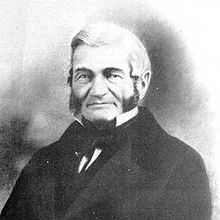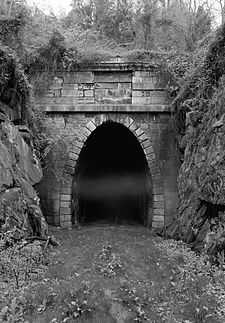Claudius Crozet
| Claudius Crozet | |
|---|---|
 | |
| Born |
December 31, 1789 Villefranche, France |
| Died |
January 29, 1864 (aged 74) Virginia, United States |
| Occupation | Civil engineer, Educator |
| Known for | Chief engineer of the Virginia Board of Public Works, including the Blue Ridge Railroad |
Benoît "Claudius" Crozet (December 31, 1789 – January 29, 1864) was an educator and civil engineer.
Crozet was born in France. After serving in the French military, in 1816, he immigrated to the United States. He taught at the U.S. Military Academy at West Point, New York, and helped found the Virginia Military Institute at Lexington, Virginia. Crozet was Principal Engineer for the Virginia Board of Public Works and oversaw the planning and construction of canals, turnpikes, bridges and railroads in Virginia, including the area which is now West Virginia. He became widely known as the "Pathfinder of the Blue Ridge."
Early life, family
Claudius Crozet was born in Villefranche on December 31, 1789. He attended a special engineering school, the École Polytechnique and graduated as sub-lieutenant on October 1, 1807. Crozet studied bridge building, and graduated from the Imperial Artillery School as a second lieutenant on June 9, 1809. Crozet resigned from military duty on April 11, 1816.
On June 7, 1816, in Paris, Crozet married Agathe Decamp.
Immigration to United States
Late in fall of 1816, Crozet and his bride headed for the United States. Almost immediately after arriving, Crozet began work as a professor of engineering at the U.S. Military Academy at West Point, New York.
While at West Point, Crozet is credited by some as being the first to use the chalkboard as an instructional tool. He used the "Elementary Course of Civil Engineering", translated from the course of M. J. Sganzin at the École Polytechnique. He also designed several of the buildings at West Point. Thomas Jefferson referred to Claudius Crozet as "by far the best mathematician in the United States." He also published A Treatise on Descriptive Geometry while at West Point.[1]
Life in Virginia
Virginia Board of Public Works
In 1823, Crozet was elected Principal Engineer and Surveyor for the Virginia Board of Public Works. He resigned from his duties at West Point, and brought his wife and two children (a boy and a girl) with him to live in Richmond, Virginia.
Virginia's Board of Public Works was very active in promoting the development of canals, roads, and railroads. His work included approving various proposals and determining their engineering feasibility. At the time, Virginia extended all the way from the Atlantic Ocean to the Ohio River and was the largest state east of the Mississippi River. It included what is now the State of West Virginia. Crozet worked on hundreds of transportation projects, such as the Northwestern Turnpike.
Typical of his many projects of this nature was the Chesterfield Railroad, the first in Virginia, the plans of which he examined before Board of Public Works funds were approved. It began operations in 1831.
In 1832, Crozet left Virginia to work in Louisiana. However, he returned to his old job in Virginia in 1837 to work on roads, canals, railroads and other points of necessity for the state. By this time, some railroads were already under construction and the canal system had reached its potential. He left office in 1843 after losing support of canal owners when he correctly forecast the future advantages railroads would hold for Virginia. Authoring textbooks on highway, railroad and aqueduct design, his 1848 map of the entire state was the first since the one prepared by Peter Jefferson, father of Thomas Jefferson, over a century earlier.
Virginia Military Institute

Crozet was one of the founders of Virginia Military Institute (VMI) at Lexington, Virginia, a major training institution for engineers and militia officers for Virginia and the South. When VMI opened in 1839, Crozet was the architect of the college's academic program and military organization. At its first meeting, the members of the VMI Board of Visitors elected Crozet president of the Board, a position he held for six years (while remaining the state's Chief Engineer).
Blue Ridge Tunnels
In 1839, Crozet surveyed the Blue Ridge Mountains and determined that the best way to allow the Blue Ridge Railroad, an extension of the Virginia Central Railroad, to cross the mountain would be through a series of four tunnels (from east to west: Greenwood Tunnel, Brookville Tunnel, Little Rock Tunnel, and Blue Ridge Tunnel) near Rockfish Gap at Afton Mountain. The 4,273 feet (1,302.4 m) long Blue Ridge Tunnel was opened in 1856, although rail service did not begin until April 1858. At that time, it was the longest tunnel in the United States and one of the longest in the world. Dug a decade before the invention of dynamite it was considered to be an "engineering wonder of the world" and was less than a half-foot (15.2 centimetres) off perfect alignment, as construction had proceeded from either end. Upon completion of the tunnels in 1858, the Blue Ridge Railroad ceased to exist, becoming a part of the Virginia Central Railroad.
During the American Civil War, Confederate General Thomas Stonewall Jackson, a former instructor at VMI, used Crozet's tunnel to transfer his "foot cavalry" (in modern times, this would be known as a rapid deployment force) from the Shenandoah Valley to the east side of the Blue Ridge quickly, to the puzzlement and consternation of Union military leaders.
In 1868, the Virginia Central Railroad was merged with the Covington and Ohio Railroad to create the Chesapeake and Ohio Railway; the original tunnel served until it was replaced with a different alignment in 1944. Perhaps as mute testament to Crozet's extraordinary skills, despite advances in technology from the 1850s, the "new" mid 20th century tunnel was 4 feet (121.9 cm) off-center, in comparison with only 6 inches in Crozet's earlier project.
Death and legacy
Crozet died in 1864. Hundreds of plans and drawings which he oversaw have been retained in the archives of the Library of Virginia.
The town of Crozet, Virginia was named in his honor in 1870.[1] The original Blue Ridge Tunnel is now proposed for a "rails-to-trails" project sponsored by Nelson County. When completed, it will be the third-longest pedestrian tunnel in the nation.
The dining hall at the Virginia Military Institute is also named in his honor. It has been affectionately nicknamed "Club Crozet" by the Cadets.
External links
- Library of Virginia official website
- Virginia Historical Society official website
- The Staunton-Parkersburg Turnpike in West Virginia was designed by Claudius Crozet
References
- ↑ 1.0 1.1 Carroll, Clover. "Claudius Crozet’s Richmond Sojourn". Crozet Gazette. Crozet Gazette. Retrieved 19 December 2011.
- Couper, William (1936), Claudius Crozet: Soldier-Scholar-Educator-Engineer (1789-1864); Charlottesville: Historical Publishing Co.
|